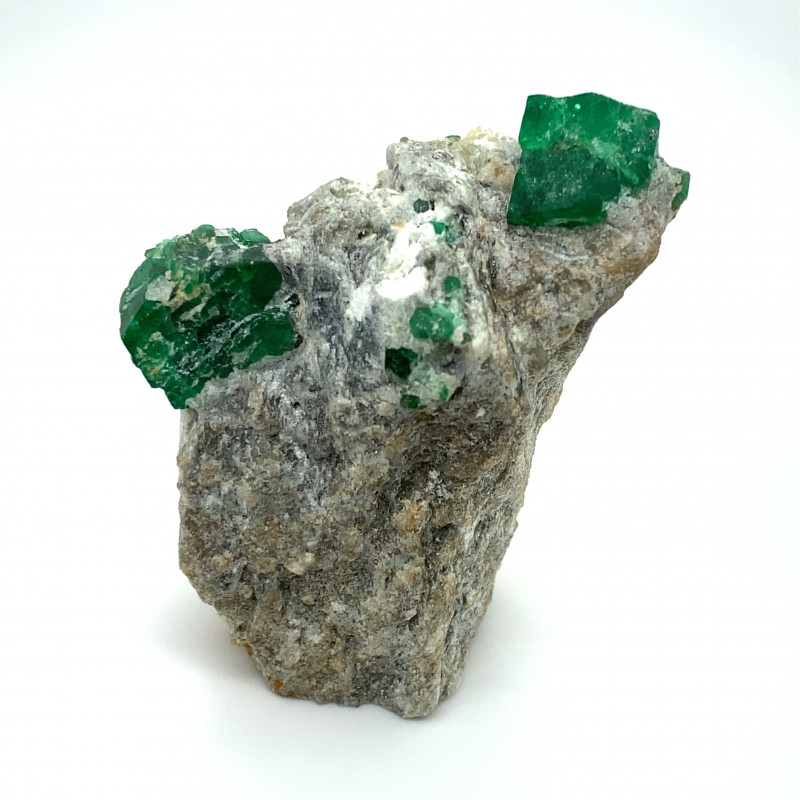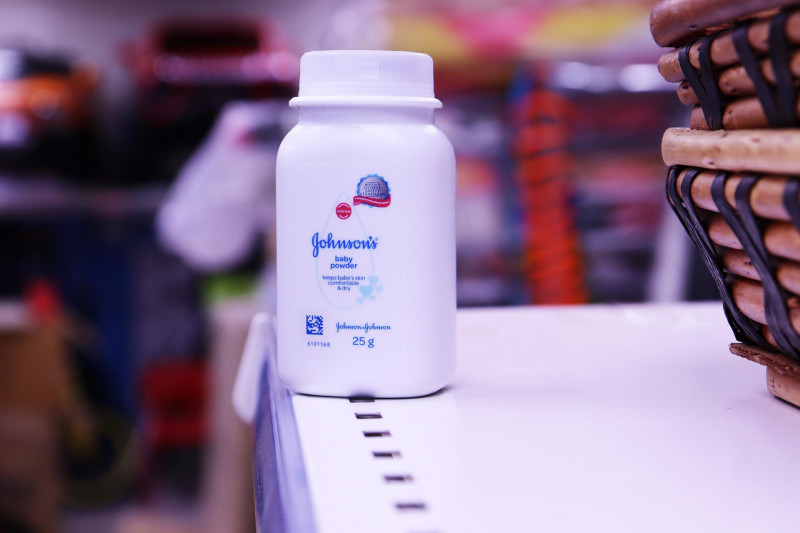Talc Mineral: Properties, Meanings, Value & More
 Talc is a natural clay mineral known for being the world’s softest material and for its powdered form, known as talc powder or talcum powder. While it’s associated with other gemstones, talc isn’t often thought of as a gem.
Talc is a natural clay mineral known for being the world’s softest material and for its powdered form, known as talc powder or talcum powder. While it’s associated with other gemstones, talc isn’t often thought of as a gem.
Why is talc not considered to be a gemstone? It’s too soft to use in jewelry. However, certain talc-rich stones like soapstone are used for decor!
Additionally, talc is an important ingredient in numerous products, along with having significant industrial uses.
Today, you’ll get the 411 on talc’s uses, history, healing properties, varieties, and prices!
 Image Credit: Rob Lavinsky, iRocks.com – CC-BY-SA-3.0
Image Credit: Rob Lavinsky, iRocks.com – CC-BY-SA-3.0
About Talc Stone
Talc, sometimes called “kerite,” can form as crystals or massive stones, though crystals are rare. In its purest form, talc color is white to colorless with a pearly luster. However, inclusions like iron or aluminum oxide can create other colors like brown, gray, yellow, pink, and more.
When people say “talc,” they may be referring to one of four meanings:
Talc mineral
Talc’s rock varieties (which we’ll cover in a bit)
Industrial-grade talc powder
Cosmetic talc powder
Speaking of, what is talc used for?
Talc Uses
Talc ingredients span various industries. Names like talc, talcum powder, magnesium silicate, cosmetic talc, or talcum all refer to talc. Usually, talc is crushed up and dried into soft white talcum powder, which is used alone or incorporated into other ingredients.
The array of applications comes from its unique properties:
Absorbent and friction-reducing: Keeps skin dry and rash-free; Prevents lumps from forming in ground-up or powdered ingredients
Greasy texture: Lubricates to make cosmetics smooth and silky
Thickening: Added to cakes, paints, and ceramics
Resistant to electricity and heat: Used in science lab counters, rubber, and electrical switchboards
On the mineral side of things, what are the characteristics of talc?
Talc Specifications & Characteristics
The talc chemical formula is Mg3Si4O10(OH)2, meaning it's a hydrated magnesium silicate. Common impurities are fluorine, iron, and aluminum.
Talc’s slippery texture comes from its structure: thin, stacked sheets that aren’t held together well, so they slip apart easily.
In the original Mohs mineral hardness scale, talc hardness was the standard 1 ranking, meaning the least scratch-resistant.
Factors like toughness and cleavage also play a role in durability. Unfortunately, talc cleavage is perfect (the weakest type), making it vulnerable to breakage, too.
Here are all of talc’s mineral characteristics:
Color: Usually green, white, or gray; Sometimes brown, yellow, pink, blue, black, or colorless
Crystal structure: Monoclinic or triclinic
Luster: Pearly, greasy, or dull
Transparency: Translucent (crystals) or opaque (masses)
Refractive index: 1.54-1.59
Density: 2.55-2.83
Cleavage: Perfect on [001]
Fracture: Uneven and flat, fibrous, or micaceous
Streak: White
Luminescence: Fluorescence sometimes present in soapstone variety; Pink, yellow, or green in SW-UV & light pink, greenish-yellow, or yellow in LW-UV
Pleochroism: Sometimes present in dark stones; Weak; Colorless to somewhat brown

Types of Talc
Talc doesn’t have the same kinds of varieties as many semi-precious gemstones. Depending on who you ask, talc either has one or two varieties: soapstone and steatite.
Soapstone is a dense, magnesium-rich metamorphic rock largely composed of talc masses compacted together, along with other minerals. It has a foliated structure (thin sheet stacks). Some call it “soaprock” or “saponite.”
However, miners and craft sellers often use “soapstone” as a general term for soapy, soft rocks often used in sculptures. In reality, many of the stones they’re referring to are serpentine or alabaster.
Steatite: Soapstone Synonym or Variety?
Some use “steatite” as a synonym for soapstone, but others distinguish the two.
The latter party considers steatite a soapstone variety that’s unfoliated and almost entirely talc.
Both soapstone and steatite (if you separate them) have a slightly higher hardness than talc, between 1 and 2.5. So… still pretty soft!
Talc (Soapstone) Value Properties
Talc itself isn’t sold for jewelry or decor, but soapstone is! Below, we’ll highlight the factors that influence soapstone’s value.
Color
Soapstone’s color often varies by its source, but includes white, gray, green, brown, and red. It may have elements of white, blue, or green. Many are gray to grayish-green.
Cut
Soapstone is almost always carved or sculpted, with some rare cabochons.
Artistic soapstone includes figurines and sculptures. Some architectural soapstone options are cookware, bar tops, and sinks.
Size
Soapstone rough is often huge, lending itself to multiple-pound carvings. Prices are higher for larger carvings.
Treatments
When heated to 1,830–2,190 °F (1,000–1,200 °C), soapstone changes into two new stones: cristobalite and enstatite. Subsequently, the hardness increases to 5.5-6.5.
You know what it can become, but what does talc crystal do for you?

Talc Healing Properties
It may not be a gemstone, but talc is a healing stone!
Colorless to white talc, like all white gemstones, can awaken higher spiritual awareness. Unsurprisingly, these crystals are perfect chakra stones for the center of spirituality: the crown chakra!
Green talc, along with other green gems, can provide nurturing, grounding, and stress-reducing benefits.
Let’s look closer at the physical and emotional healing abilities.
Physical Healing
Talc crystals are said to help you establish a good sleep schedule, especially anxiety-induced insomnia. They can also help the kidney and liver function better.
Emotional Healing
Emotionally, talc is soothing and grounding. Crystal healers love it for bringing stillness and promoting mindfulness. Many recommend meditation with talc to reduce stress or bring better sleep.
Just like crystal healing itself, talc goes back centuries!
Talc Meaning & History
The word “talc” derives from the Arabic talq and Persian tālk. Translations differ between “pure” or “mica,” for its similarity to mica minerals.
Ancient peoples called lots of minerals talc, including selenite. The Medieval Latin term talcum once referred to many different shiny minerals.
Though evidence is scarce, Georgius Agricola is said to have officially named talc in 1546. However, as you may have guessed, talc goes way further back, particularly its soapstone variety.

Ancient Talc & Soapstone History
The first discovery of talc or soapstone is unclear but goes back millennia.
Some of the earliest archeological evidence is a moose head soapstone carving from Finland called Elk’s Head of Huittinen dated to roughly 7,000 BC.
During the Stone Age, Scandinavians started using carving soapstone. They were the first to realize soapstone’s heat absorption and slow heat loss. This property was useful for metal-casting molds (along with cooking tools and fireplace insulators), which put Scandinavia into the Bronze Age around 1750 BC.
East-coast Native Americans likely discovered soapstone in the Appalachian Mountains. They carved assorted items that date back 3,000-5,000 years ago and include soapstone tobacco pipes, decor, and bowls.
Even earlier evidence from about 8,000 years ago revealed west-coast Native Americans canoed 60 miles to San Clemente Island for soapstone. They carved soapstone bowls and human figurines.

Modern Talc History & Controversy
If you ask “what is talc known for?” nowadays, you’ll likely hear negative connotations. Sadly, these associations are warranted in many cases.
In 1886, Robert Wood Johnson and his brothers started Johnson & Johnson™ (J&J). Soon after in 1894, J&J made the first talcum powder and marketed it as baby powder with the company slogan “Safety First.”
But J&J learned their talc-based products weren’t safe decades ago. Researchers told them the products contained asbestos and posed an ovarian cancer risk.
Instead of adding the recommended warning label, J&J started marketing another talcum powder product (Shower to Shower) and kept lawsuits under-wraps for years.
A popular 2018 Reuters article presented evidence of asbestos-positive tests on J&J’s baby powder back to 1971 and proof the company knew about the asbestos.
In the last few years, multimillion-dollar lawsuits against J&J from customers who suffered ovarian cancer or mesothelioma finally made an impact. In 2020, J&J officially took its talc-based baby powder off the US and Canadian markets.
All that said, is mineral talc safe? If it doesn’t contain asbestos, it’s safe. Testing is required to know that, so always do your research and check the funding sources of organizations providing that information.
Why is there asbestos in talc at all? It has to do with its formation.

Talc Formation & Sources
Talc and asbestos often form close together, so talc from deposits with asbestos often gets contaminated. These deposits commonly have other cancer-causing minerals like tremolite, too. However, not every talc deposit contains asbestos.
Formation-wise, what type of rock is talc found in? Miners classify talc deposits based on the rock it forms inside, with three current categories:
Magnesium Carbonates: Silica-rich dolomite and magnesite; Accounts for over 50 percent of the world’s talc production
Serpentinites: Serpentine-rich metamorphic rocks, where talc replaces some of the serpentine minerals; Accounts for around 20 percent of talc
Alumino-Silicates: Rocks that produce clay minerals when weathered; Accounts for about 10 percent of talc
Talc forms through one of two ways: hydrothermal alteration or thermal metamorphism. Confused? Don’t worry, we’ll break each one down!
The hydrothermal alteration process starts with rocks low in silica but rich in magnesium. First, minerals like pyroxene or olivine become hydrated, changing into serpentine. Then, carbon dioxide transforms serpentine into magnesite and talc.
The thermal metamorphism process is low-grade, meaning low to medium pressure and temperature transforms the rock, but not drastically.
Thermal metamorphism occurs in magnesium carbonate rocks like dolomite and magnesite. First, water carries the rock’s silica away, but the magnesium stays in place. The magnesium carbonates react with the silica water, creating newly talc-rich rocks.
With that in mind, where is talc found?
Mining Locations
Currently, the world’s top talc producers, in order, are China, the USA, and Japan. In the USA, Montana, Texas, and Vermont lead talc production.
Other major suppliers include:
Australia
Brazil
Canada
Central Africa
Finland
France
India
Russia
South Korea
Soapstone is less widespread. You’ll rarely find it in the Northern Hemisphere because seasonal freezing or glaciers destroy deposits. Brazil is the best soapstone source, as it lacks these conditions.
Now, how much is talc schist worth? Or soapstone?
 Image Credit: Rob Lavinsky, iRocks.com – CC-BY-SA-3.0
Image Credit: Rob Lavinsky, iRocks.com – CC-BY-SA-3.0
Talc Price & Value
Talc is incredibly affordable. Almost always sold as rough specimens, the prices range from $11-$16 by weight — about $16 for 1-2 lb pieces and $11 for 26-100 lb pieces.
Soapstone’s price is generally affordable, but more dependent on its quality, particularly historical value. For instance, an authentic, historical Inuit carving could fetch $4,000-$6,000 prices.
Modern soapstone carving prices are much lower. Small figurines are often $4-$6 each, while medium-sized carvings (8-15 inches) are typically $20-$50. Rough soapstone is the least expensive, usually around $2 per pound.
Talc Care and Maintenance
Talc is extremely delicate, and caring for crystals like this takes caution. You can easily scratch it, even with your fingernail.
To clean talc, carefully rinse it in warm water. Distilled water is best, as mineral particles in tap water may scratch the stone.
Keep talc in a vacuum-sealed or airtight container and store in a dry, cool area away from commonly frequented areas.
Want A Stone Softer Than Silk?
No matter how many minerals you’ve held, none feel quite like talc. Its soft, slippery texture perfectly reflects its soothing, calming properties. Whether you use it for a soapstone countertop or a decorative carving to display on that counter, you can revel in its relaxing vibrations — and know you hold a slice of history!
Want to explore talc and other minerals? Shop our expansive collection!
Was this article helpful?
1 person found this article helpfulRoss Sedawie
- Written - 7th May 2022
- Edited - 1st Aug 2023












